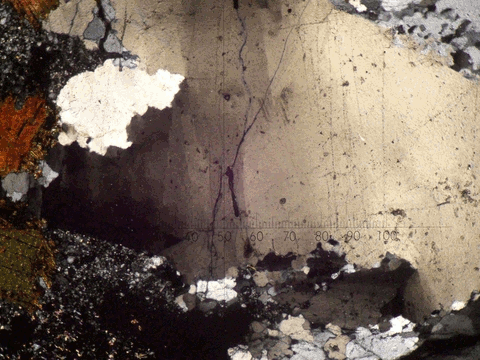
Undulose extinction
Encyclopedia


Undulose extinction or undulatory extinction is a geological term referring to the type of extinction that occurs in certain mineral
Mineral
A mineral is a naturally occurring solid chemical substance formed through biogeochemical processes, having characteristic chemical composition, highly ordered atomic structure, and specific physical properties. By comparison, a rock is an aggregate of minerals and/or mineraloids and does not...
s when examined in thin section
Thin section
In optical mineralogy and petrography, a thin section is a laboratory preparation of a rock, mineral, soil, pottery, bones, or even metal sample for use with a polarizing petrographic microscope, electron microscope and electron microprobe. A thin sliver of rock is cut from the sample with a...
under cross polarized light. As the microscope
Microscope
A microscope is an instrument used to see objects that are too small for the naked eye. The science of investigating small objects using such an instrument is called microscopy...
stage is rotated, individual mineral grains appear black when the polarization due to the mineral prevents any light from passing through. If a mineral is deformed plastically by dislocation processes without recovery
Recovery (metallurgy)
Recovery is a process by which deformed grains can reduce their stored energy by the removal or rearrangement of defects in their crystal structure. These defects, primarily dislocations, are introduced by plastic deformation of the material and act to increase the yield strength of a material...
, strain builds up within the crystal
Crystal
A crystal or crystalline solid is a solid material whose constituent atoms, molecules, or ions are arranged in an orderly repeating pattern extending in all three spatial dimensions. The scientific study of crystals and crystal formation is known as crystallography...
lattice causing it to warp. This means that different parts reach extinction at slightly different angles, giving the crystal an irregular, mottled look.
Undulose extinction is very common in quartz
Quartz
Quartz is the second-most-abundant mineral in the Earth's continental crust, after feldspar. It is made up of a continuous framework of SiO4 silicon–oxygen tetrahedra, with each oxygen being shared between two tetrahedra, giving an overall formula SiO2. There are many different varieties of quartz,...
, so much so that it is often used as a diagnostic feature of that mineral, and feldspar
Feldspar
Feldspars are a group of rock-forming tectosilicate minerals which make up as much as 60% of the Earth's crust....
of various sorts, but is possible in almost any mineral.
It is possible to identify the presence of a porphyroblast
Porphyroblast
A porphyroblast is a large mineral crystal in a metamorphic rock which has grown within the finer grained groundmass. Porphyroblasts are commonly euhedral crystals, but can also be partly to completely irregular in shape....
before the main deformation event in a metamorphic reaction, if a porphyroblast displays clear undulose extinction it is a clear sign that it existed before the main rock was created.

